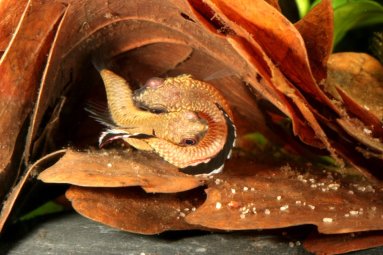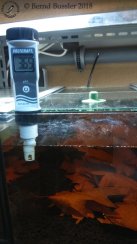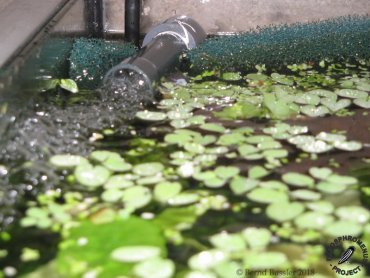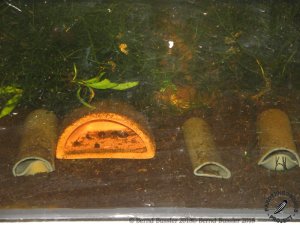A very personal experience with the difficult breeding of P. ornaticauda — by Bernd Bussler
My experiences with breeding Parosphromenus
ornaticauda
 For 15 years I have been engaged with breeding Ornaticauda.
For 15 years I have been engaged with breeding Ornaticauda.
The problems are many and apparently these problems are similar to all ornaticauda keepers and breeders.
First of all, they are hard to come by, — secondly, once aquired, they seem to disappear gradually, until there eventually are no more left in the aquarium.
They usually spawn willingly and have regular clutches, but either the eggs disappear, — are probably eaten, — or only few larvae hatch. These are then also either eaten and just disappear. I too have usually been able to raise only a few juveniles, which made it impossible to breed with the only a few offspring.
It could not stay that way, I thought.
In 2017 I got the opportunity to acquire a larger amount of ornaticauda.
I got 20 pairs, which I divided into three aquariums.
It started with the same story as always and I was fed up and wondered what I could do differently this time.
I normally have the ornaticauda in groups, in 25 liter aquariums. The ground is made of peat granules without plants.
without plants.
As equipment I only use dried oak leaves of various oak trees, preferably the bog oak. The leaves are large and have pointed ends. Moreover, they do not decompose so quickly and need only be exchanged every 4 — 6 months.
The statement “no plants in the aquarium” I would like to explain:
It is of course nice if an aquarium is planted and plants provide good water quality and hiding places, and I am always amazed at how beautiful other aquariums look with plants.
But since my aquariums are exclusively for breeding, I have to think in a practical ways. With me, everything has to be easy to check and above all, I have to see at a glance what’s going on in the tank.
Furthermore, the Ph value in my setup will go down to the value of 3, in which a plant will not survive for a long time. So I renounce from the outset on plants, dead plants not only look ugly, they also burden the water considerably.
I have the so-called Hamburger Filter, a foam wall at the back of the aquarium behind which an air lift lifts the water back into the aquarium.
As a spawning aid, I take about 10 cm long plastic pipes with a diameter of 1 to 1.8 cm.
They are closed on the back with a foam piece. The open side is placed near the front screen of the aquarium. This way I can always see with a flashlight whether and what is in the tube.
I have always been annoyed that my ornaticauda always spawn but the result was miserable, either the clutch disappeared or only one or three juveniles. This way you can not save a species.
I looked at it for a few weeks and decided on a different route than usual.
First of all, I completely separated males and females. Then I cleaned and set up two aquariums.
After that I socialized two females and one male, and then it was time to wait. I knew from my own experience, from friends and reports, that it probably was depending on the male whether the clutch will be something or not.
Now I waited until they produced eggs and watched what happens. I let the males spawn three times, but if they did not work it out, they were caught and replaced by another male.
The males who did not care properly came into an extra aquarium, so I could not swap them with the males who have not yet spawned.
And behold, after several attempts, I had a male who perfectly cared. Finally I have been able to take out a whole clutch of juvenile fish, usually between 10 to 30, and to raise them separately. The whole action has been going on for about half a year now and I had more juvenile fish than I thought possible.
Now many F1 Ornaticauda swim in my aquarium. And I hope that the F1 generation is hopefully a little easier in the offspring.
However, I have not tried breeding with the F1 generation yet. So there is no guarantee that it will be easier, but I am in good spirits that I can continue this way.
My “superman” is still doing very well and I want to try to breed as many juveniles as possible, because at some point the male is too old to continue.
But until then I hope to have a lot of Ornaticauda to be able to continue with the offspring.
Greetings Bernd Bussler

